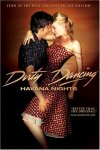BUY THE DVD:
|


|
|
|
SYNOPSIS:
| |
an american girl and her parents arrive in cuba right before the revolution breaks out and forms a romance with a poor cuban teenager.
|
|
|
MOVIE FACT:
| |
the plot is loosely based on the life story of producer joann hansen, who moved to cuba with her family in 1958, thus, the "based on true events" title.
|
|
|
RATING:
|


two out of four possible stars
|
|
|
|
Although lovers of the original Dirty Dancing will never be able to appreciate this film as they do the original, there are a few scenes in Havana Nights which will bring back the high energy of the original. Though the steamy chemistry between Jennifer Grey and Patrick Swayze is in no way duplicated by stars Romola Garai and Diego Luna, the dance scenes are full of pep and enthusiasm. When the focus of the film turns to the violence of the Cuban Revolution, the film's romantic angle, arguably the most important aspect of the film, is lost in the fighting, making the scant romantic chemistry between Garai and Luna even more difficult to find. The chemistry seems forced at times, instead of natural and inevitable.
While the oppressive cultural context described in the first "Dirty Dancing" film was an ever-present idea, it was never an over-riding factor in the presentation of the film. But in this sequel, the last climactic dance scene is literally torn apart by the revolution and after viewing the film, audience members will have memories of a communist revolution dancing in their heads rather than the beautiful motions of Latin dancers and Cuban music. True love (as hokey as that idea tends to be) was the ultimate idea of the 1987 film, and the "love" in Havana Nights is put on the back burner too often. The love between the two lead characters should have been the entire focus of the movie.
In fact, when the two lead characters, Garai's "Katey" and Perez's "Xavier," finally do try to make the leap from dancers to lovers, their tryst is interrupted by the overpowering la revolución. As important and significant an event as the Cuban Revolution was, the idea of it invades into the romantic territory of the film far too heavily. Whereas "Baby" and "Johnny" were fighting against social and societal pressures of 1950's America, it is that more benign threat of social confusion (rather than pure and complete governmental anarchy) that accompanies the picture, allowing the love story to constantly take the floor. Viewers will not be able to focus on that very important aspect in Nights, however, much to the love story's detriment. Further time spent between the "lovers" could have made their relationship feel stronger.
Something that might catch viewers off-guard is a strange, nearly cameo appearance, by Patrick Swayze. Though he's not referred to as his famous character, "Johnny," he seems to pop up out of nowhere and disappear before his character can really make sense in the overall story. While it is entertaining, at first, to see Swayze put on his dance shoes again (he plays a dance instructor in two scenes), his dialogue, character, and appearance in the film all come out of left field. The screenwriters should have worked harder to blend his character into the film. Or they should have turned his appearance into a true cameo instead of giving him an extended dance lesson sequence with one of the lead stars. Because of his lead role in the first film, it seems strange for him to become Garai's dance partner for the length of time he does.
In their various stock roles (many of which mirror like roles in the first film), the supporting cast plays their roles with sufficient skill. Sela Ward, playing Garai's mother "Jeannie Vendetto," comes to the floor with a few unexpected quips and welcome pieces of dialogue, as do other members of the cast. Despite the film's quite predictable plot (something which really isn't bothersome when regarding the larger picture), the supporting roles from Jonathan Jackson, John Slattery, and Mika Boorem are handled with finesse by each actor, their talents beefing up the rather simple script. The dialogue is around fifty percent innovative and fifty percent dopey, though the actors seem to have the ability to raise the percentage of the former.
In the end, it's difficult to call this film a true "sequel" to the 1987 film that started the Dirty Dancing craze. Filmmakers have been after a sequel to the ever-popular film for years, but Havana Nights hardly deserves to carry the torch. As is the case with so many sequels, Havana Nights seems to have been penned with the idea of banking on the popularity of the original being able to lure potential audience members into the Cineplex. But this film won't have the legs of the original. It simply won't stand the test of time as has the original. This film is more of an afterthought to a memorable main course. It is but a weak coffee chaser when it should be instead a scintillating dessert.
Review by Kelsey Wyatt.
| |
|